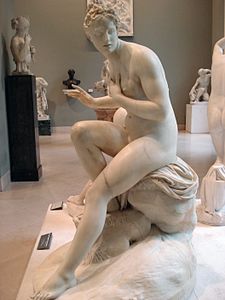This is an old revision of this page, as edited by Lord Cornwallis (talk | contribs) at 16:41, 2 January 2025 (←Created page with '{{Short description|1814 art exhibition in Paris}} thumb|''] The '''Salon of 1814''' was an art exhibition held at the Louvre in Paris from 5 November 1814. It was the first Salon (Paris) to be held since the defeat of Napoleon and the Bourbon Restoratio...'). The present address (URL) is a permanent link to this revision, which may differ significantly from the current revision.
Revision as of 16:41, 2 January 2025 by Lord Cornwallis (talk | contribs) (←Created page with '{{Short description|1814 art exhibition in Paris}} thumb|''] The '''Salon of 1814''' was an art exhibition held at the Louvre in Paris from 5 November 1814. It was the first Salon (Paris) to be held since the defeat of Napoleon and the Bourbon Restoratio...')(diff) ← Previous revision | Latest revision (diff) | Newer revision → (diff) 1814 art exhibition in Paris
The Salon of 1814 was an art exhibition held at the Louvre in Paris from 5 November 1814. It was the first Salon to be held since the defeat of Napoleon and the Bourbon Restoration that brought Louis XVIII to the throne. It featured a mixture of paintings and works of sculpture.
One of the most celebrated artists of the Napoleonic regime Jacques-Louis David had gone into exile and was absent from the Salon. Several of the works had appeared at earlier exhibitions such as Théodore Gericault's The Charging Chasseur which had featured in the Salon of 1812. By contrast Géricault's The Wounded Cuirassier was shown for the first time. Jean Auguste Dominique Ingres wanted his entries "to cause some noise" and demonstrate the supremacy of history painting above all other genres. Anicet Lemonnier enjoyed success with her depiction of eighteenth century Paris In the Salon of Madame Geoffrin in 1755.
François Gérard, a noted painter of the Napoleonic era, rushed to complete his Portrait of Louis XVIII in time for the exhibition. It was followed by the Salon of 1817 which was more overt in its support of the Bourbon dynasty.
Gallery
Paintings
-
 Portrait of Prosper de Barante by Girodet
Portrait of Prosper de Barante by Girodet
-
 The Charging Chasseur by Théodore Géricault
The Charging Chasseur by Théodore Géricault
-
 The Wounded Cuirassier by Théodore Géricault
The Wounded Cuirassier by Théodore Géricault
-
 In the Salon of Madame Geoffrin in 1755 by Anicet Charles Gabriel Lemonnier
In the Salon of Madame Geoffrin in 1755 by Anicet Charles Gabriel Lemonnier
-
 Vue du parc du Raincy by Pierre-Antoine Marchais
Vue du parc du Raincy by Pierre-Antoine Marchais
-
 Virgil Reading his Aeneid to Augustus by Jean-Bruno Gassies
Virgil Reading his Aeneid to Augustus by Jean-Bruno Gassies
-
 Portrait of Napoléon-Joseph de Colbert-Chabanais by Jeanne-Elisabeth Chaudet
Portrait of Napoléon-Joseph de Colbert-Chabanais by Jeanne-Elisabeth Chaudet
-
 Pope Pius VII in the Sistine Chapel by Jean-Auguste-Dominique Ingres
Pope Pius VII in the Sistine Chapel by Jean-Auguste-Dominique Ingres
-
 The Death of Malek-Adhel by Césarine Davin-Mirvault
The Death of Malek-Adhel by Césarine Davin-Mirvault
-
 Portrait of Joseph Souberbielle by Adèle Romany
Portrait of Joseph Souberbielle by Adèle Romany
-
 Portrait of Mme Granier in the role of Colinette by Adèle Romany
Portrait of Mme Granier in the role of Colinette by Adèle Romany
Sculptures
-
 Suzanne Bathing by Pierre-Nicolas Beauvallet
Suzanne Bathing by Pierre-Nicolas Beauvallet
-
 Homer by Philippe-Laurent Roland
Homer by Philippe-Laurent Roland
References
- Crow p.20
- Harkett & Hornstein p.203
- https://pop.culture.gouv.fr/notice/joconde/000PE001304
- https://pop.culture.gouv.fr/notice/joconde/000PE001302
- Harkett & Hornstein p.144
- Lilti p.1
- Sérullaz p.102
Bibliography
- Crow, Thomas. Restoration: The Fall of Napoleon in the Course of European Art, 1812-1820. Princeton University Press, 2023.
- Harkett, Daniel & Hornstein, Katie (ed.) Horace Vernet and the Thresholds of Nineteenth-Century Visual Culture. Dartmouth College Press, 2017.
- Lilti, Antoine. The World of the Salons: Sociability and Worldliness in Eighteenth-century Paris. Oxford University Press, 2015.
- Sérullaz, Arlette. French Painting: The Revolutionary Decades, 1760-1830. Australian Gallery Directors Council, 1980.